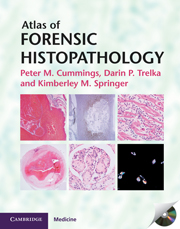Foreword
Published online by Cambridge University Press: 05 August 2013
Summary
Histopathology examination is the daily bread and butter of the general or special- expertise pathologist. However, for many years histopathology had been under-evaluated in many Medical Examiners’ and Coroners’ Offices here in the USA, and had not been treated much better in the remainder of the world. Nevertheless, in recent decades there has been an increased awareness of the central importance of forensic microscopy in many forensic cases, and the number of histopathology books has increased significantly. However, there are still very few atlases of forensic pathology and by publishing their Atlas of Forensic Histopathology, Drs. Cummings, Trelka and Springer have made a highly valuable contribution to forensic medicine. All three authors are experienced and highly regarded Medical Examiners, with an aggregate experience of decades in forensic histopathology. While textbooks of forensic histopathology are valuable, the number of illustrative photos included is always much less than that presented in a microscopy atlas. In the forensic pathology world, as much as in the world at large, a picture is better evidence than a thousand words. Besides presenting a wealth of forensic microscopic illustrations, the authors of this atlas have eminently succeeded in selecting a wide spectrum of color illustrations from both common and difficult type of cases, including the challenging issues of aging of natural, chemical, and traumatic injuries. The legends to the illustrations are very clear and are accompanied by guiding tables of differential diagnoses and time-related pathogenetic changes. The atlas is valuable both to the novice forensic pathologist and to the experienced one, facing a difficult case or in need of supportive or documentary evidence.
- Type
- Chapter
- Information
- Atlas of Forensic Histopathology , pp. ix - xPublisher: Cambridge University PressPrint publication year: 2000



